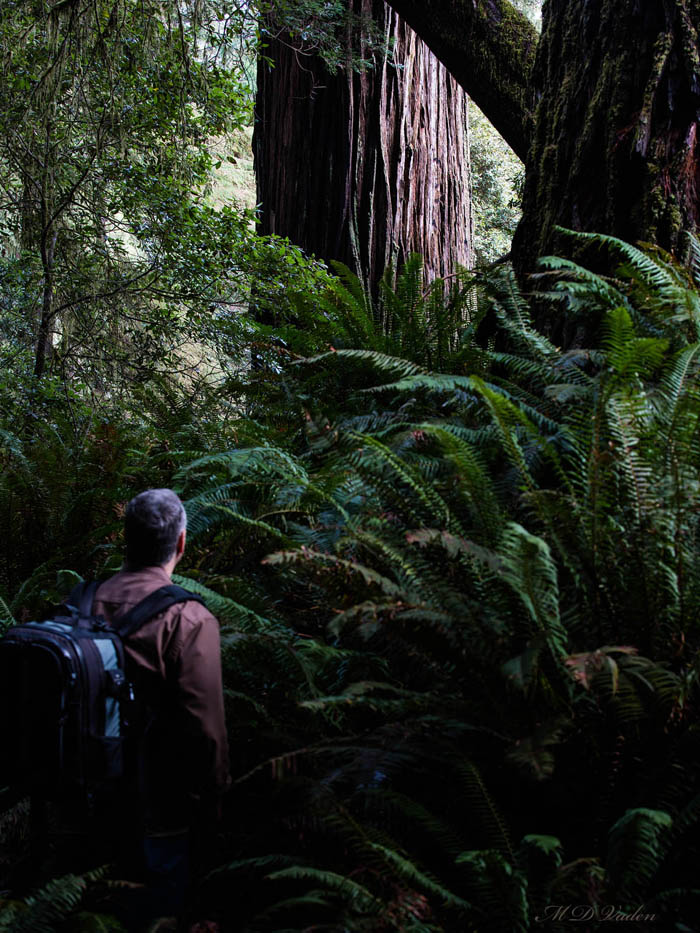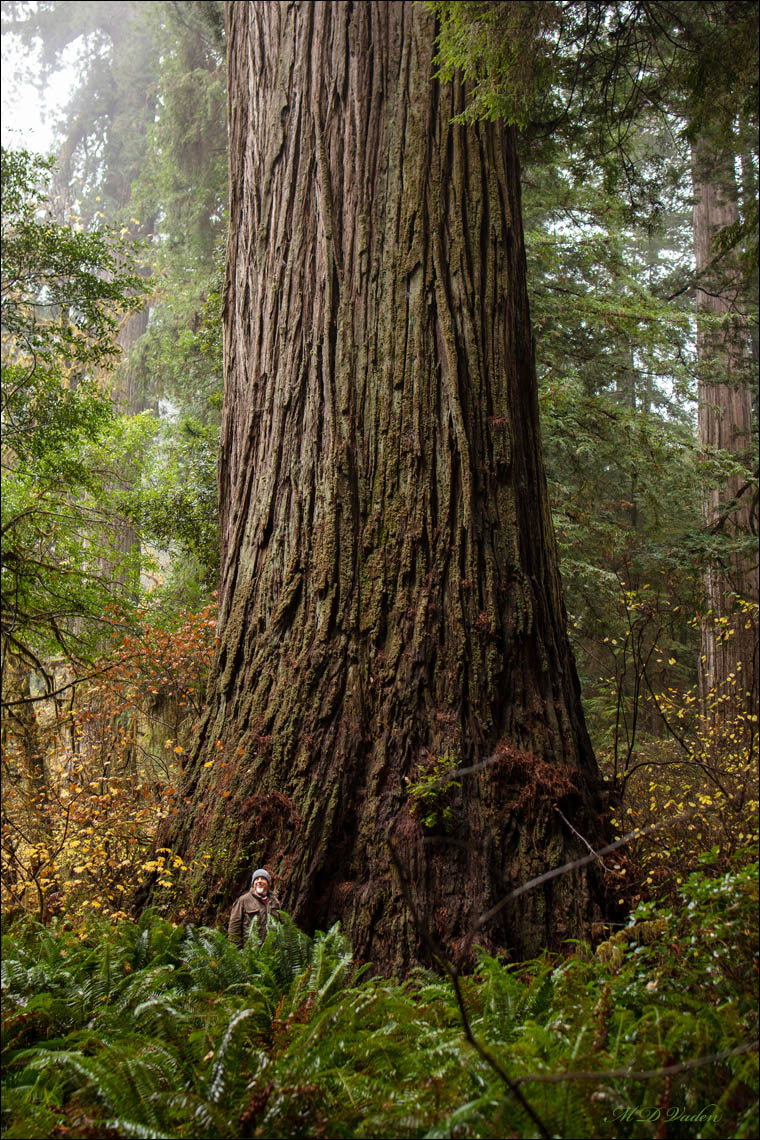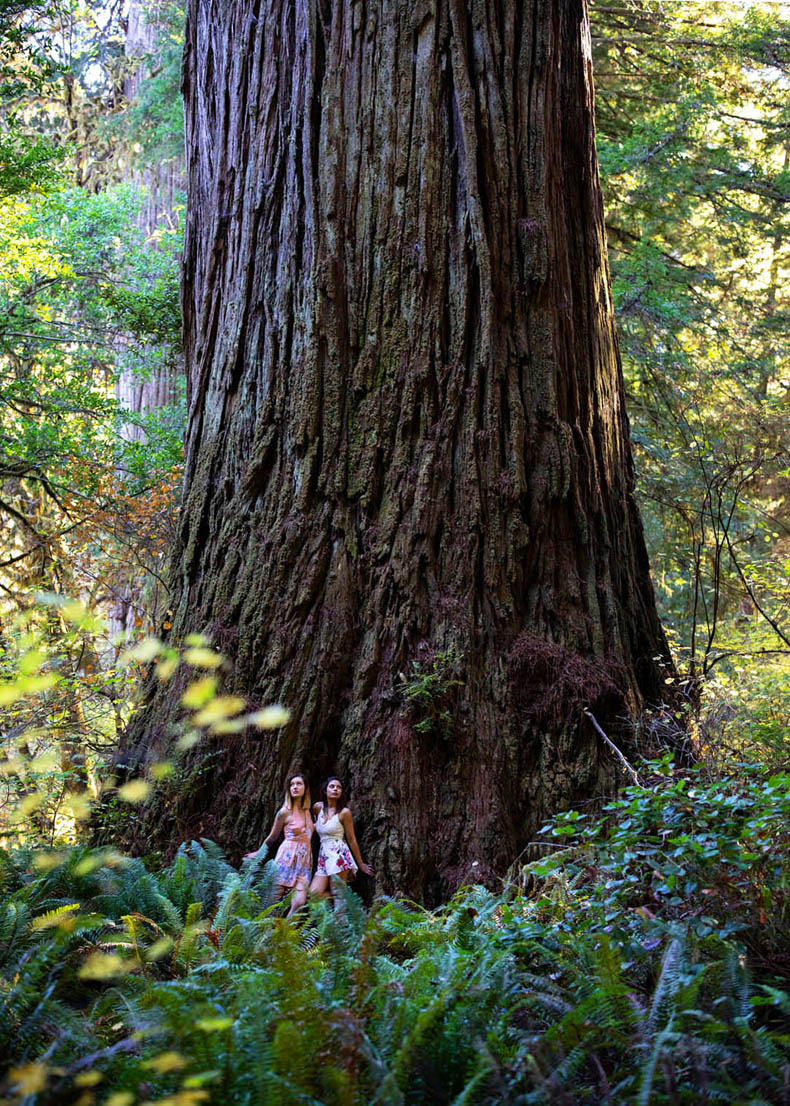
Del Norte Titan Coast Redwood | 4th
by Mario Vaden
This is Del Norte Titan (DNT) coast redwood. My first visit was a rainy day back in 2008. The location is Jedediah Smith Redwoods State Park. Presently in 2014, visitor centers may or may not tell you how to get here. But I provided directions to nearby giants at my Grove of Titans page following 2017 news publicity. This giant redwood isn't close to a primary trail. An old social trail passes near the DNT that may have been used to reach wading or fishing years ago. This grove is one of few places I've seen black bear in the park.
I chose this redwood and page to explain why redwoods and other evergreens are stronger standing alone and weaker in groves. Yes, contrary to reviews you may have heard from The Hidden Life of Trees by Peter Wohlleben. I will explain fully toward the end of the page. Just look for a big bold heading solo redwoods are strong
306 ft. tall . . . . 23.7 ft. dbh diameter (2009)

advertisement
Del Norte Titan will appear as a single trunk with no significant basal stems. Its development seems to originate from triple trunks which fused or pressed tightly together and became so large that for all practical purposes you can call it a redwood (singular). The two largest stems were toward the north and a smaller third stem was on the southeast side or what some visitors call the back side. But it happened so long ago, the evidence will probably vanish in a few more centuries. Continue reading after image ...
Image: approaching the Del Norte Titan from the opposite side of a small ridge.

Del Norte Titan was connected to a significant typo a few years back. The Redwood Ed released A Guide to the Coast Redwoods for Teachers and Learners stating on page 42 that Del Norte Titan is only 156 feet tall. They probably mixed up facts and numbers, because Dr. Robert Van Pelt back in 2001 wrote that Del Norte Titan has a 5 foot diameter & 155 foot tall reiterated trunk. Redwood Ed probably took the extra trunk measurement and applied it to the entire redwood. That was an educational redwood resource and not Ed Gilbert also known as Redwood Ed, the retired guide.
Image: A rainy Autumn day.

Del Norte Titan was discovered May 11, 1998 by Steve Sillett and Michael Taylor after an day-long cross-country exploration through the park. The DNT as it's sometimes called is within an area called the Grove of Titans. According to Dr. Steve Sillett, this was one of the most vigorous and physically demanding bushwhack he ever experienced. The Del Norte Titan was discovered shortly after Lost Monarch and Screaming Titans on the same day in May, 1998.
They also found New Hope redwood earlier that day, plus Ol' Jed Douglas Fir which became the largest known of that species in California. In 2009, Chris Atkins, Steve Sillett and myself went to see Ol' Jed in the park's midst. The old Doug fir kicked the bucket but was still standing. Although, we need to go back again. I've seen needle-bearing evergreens completely defoliate before and recover. We didn't remove any bark to check the cambium condition or color, and just moved along.
Del Norte Titan does not have the largest Coast Redwood trunk but among single-trunked Coast Redwoods could be larger than Lost Monarch if basal stems are omitted from wood volume. Unless of course, people consider my opinion that the DNT is really 3 trunks merged into what looks like one. It's so subtle to decipher looking, that people may as well choose however they feel it looks to them once they see it. Here is a view of the upper canopy. Very old and fairly complex.

2009 data for Del Norte Titan redwood is 306.2' or 93.6 m high, 23.7' or 7.22 m diameter, and 37,200 cubic feet wood volume. The main trunk is still 12.1 feet diameter at 180 feet high, but quickly tapers where reiterated stems emerge. There were 43 reiterated stems which account for 9.5% of the total wood volume. The largest reiterated stem was 5.24 feet diameter and at one point is connected to the main trunk by a fused horizontal 4.59 foot diameter branch. One saddle of wood between reiterated trunks had 6.56 feet deep canopy soil. The main trunk is decayed and hollow above 278 feet. Some branches are up to 98 feet long, some fused together. The main trunk has dead cambium between 197 ft. to 229 ft., where shrubs grow on it. Del Norte Titan supports some epiphytes including flowering currant, evergreen huckleberry and small tan-oak in the canopy. The DNT probably supports as many species of life standing than redwoods that have fallen over and decayed. Maybe more, because birds can nest, etc.. Dr. Steve Sillett described one of the crown's most interesting features being accumulations of broken stems and branches trapped about 170 ft. up. Those hold even more organic matter and form something described as floating rafts. Robert Van Pelt wrote Del Norte Titan had 1222 AF points.American Forests points are used to rank champions of various species. At 106' up the trunk, two huge reiterated trunks also reach up for the sky. One of them was measured at 5' thick and 155' tall.
Groves redwoods are weaker and solo redwoods are stronger.
It surprised me this needed to be explained. It should be obvious. But redwoods and many other trees are not stronger in groves -- but weaker. Some people responded "haven't you read The Hidden Life of Trees by Peter Wohllelben" and "trees communicate with one another and share resources, like through roots and mycorrhizal fungi association". My response "pay attention to the trees, these redwoods are still weaker in groves". Here's their problem -- they took one or more factual things about redwwoods and twisted a false narrative. So let me spell out some obvious growth characteristics of coast redwoods, Douglas firs and other evergreens.
Groves are thick with shaded soil. When soil remains moist for longer periods, roots remain closer to the surface, causing a weaker anchoring. But out in the open where there is more sunlight and wind, surface soil often dries faster, causing deeper roots. And deeper roots are a stronger anchor.
This is why I added this teaching to this Del Norte Titan page. The DNT is very open around it with other redwoods set a good distance from it. For the more part is stands on its own, dominating the space. And it shares similarity to some of the other largest titans. Most of the 10 largest redwood titans have a good amount of open space around them. That means more branches and foliage, and more foliage means more food, growth and wood.
Have you ever really paid attention to trunks in groves? Including landscape or park plantings? Nearly 100%, when I see or prune a row of evergreens like western redcedar, hemlock, etc., the inner trunks are always the skinny trunks. The trunks on the end are always the largest, maybe double the size. The end trunks have more canopy exposed to light, have more branches and foliage, producing more food and wood.
Where I grew up in Beaverton in the 1960s was mostly countryside, when the population was barely 8,000. My parents property was 2 acres, and the neighbor's 5 acres, 2 acres, 13 acres, etc.. Woodland with quite a few Douglas fir scattered around, but few were in groves. Most stood alone, with good diameters 3 feet wide to 6 feet wide. Standing mostly exposed, these has all withstood the great Columbus Day Storm of 1962.
Across the street was maybe 100 acres of dense Douglas fir forest, without question a grove. Trunk after trunk after trunk, spaced like 10 feet to 15 feet apart. It was thick and there were hundreds if not thousands of them. Eventually, as Beaverton evolved to a city of 100,000 people, this forest land was developed. Permits required that some trunks remained. It was foolish, but that's what city planning required. Like 1 of every 15 trunks was left standing --- about 10% of the Douglas firs, with houses built all around.
In the next 5 to 20 years, several storms passed through. Some strong, but nothing like the Columbus Day Storm. And what happened? The trunks on our own own neighbor properties stood fast. We owned the stronger trees, the ones that grew that way and stood out in the open all along. But the thinned forest lost 1/2 to 2/3 of the Dougas fir. Why would that be if grove trunks are stronger trunks? But the thinning revealed that grove trunks are weaker.
The truth is, grove redwoods are dependent on one another. Groves do offer a protection where the entire population buffers effects. It's almost like a socialism. But the fact remains that grove trunks are dependent and weak. If a couple trunks fall over and open a hole, wind can penetrate and damage trees that were not exposed before. That's what happened in that new neighborhood, on a grand scale. Protection was removed, leaving dependent weaklings that couldn't adjust fast enough, if ever at all.
So in a nutshell yes, redwoods and trees can transfer resources. They can buffer one another as a grove. But solo trees can develop more stout and self sufficient, while grove redwoods remain more reliant on one another.
Image: Del Norte Titan coast redwood in 2018, with two local Crescent City residents.
